belt CHEVROLET VENTURE 2003 1.G Owners Manual
[x] Cancel search | Manufacturer: CHEVROLET, Model Year: 2003, Model line: VENTURE, Model: CHEVROLET VENTURE 2003 1.GPages: 486, PDF Size: 3.3 MB
Page 1 of 486
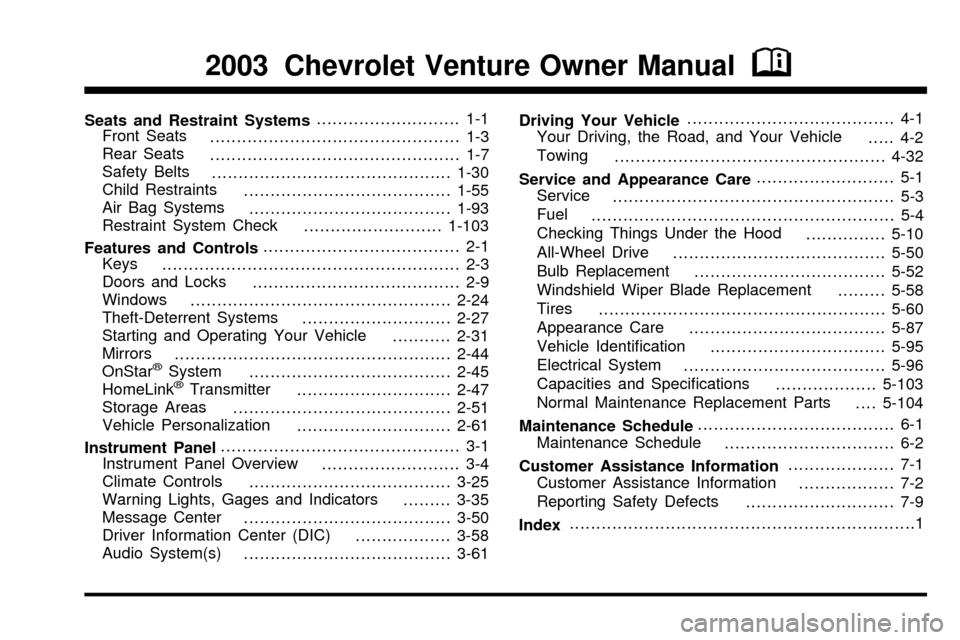
Seats and Restraint Systems........................... 1-1
Front Seats
............................................... 1-3
Rear Seats
............................................... 1-7
Safety Belts
.............................................1-30
Child Restraints
.......................................1-55
Air Bag Systems
......................................1-93
Restraint System Check
..........................1-103
Features and Controls..................................... 2-1
Keys
........................................................ 2-3
Doors and Locks
....................................... 2-9
Windows
.................................................2-24
Theft-Deterrent Systems
............................2-27
Starting and Operating Your Vehicle
...........2-31
Mirrors
....................................................2-44
OnStar
žSystem
......................................2-45
HomeLinkžTransmitter
.............................2-47
Storage Areas
.........................................2-51
Vehicle Personalization
.............................2-61
Instrument Panel............................................. 3-1
Instrument Panel Overview
.......................... 3-4
Climate Controls
......................................3-25
Warning Lights, Gages and Indicators
.........3-35
Message Center
.......................................3-50
Driver Information Center (DIC)
..................3-58
Audio System(s)
.......................................3-61Driving Your Vehicle....................................... 4-1
Your Driving, the Road, and Your Vehicle
..... 4-2
Towing
...................................................4-32
Service and Appearance Care.......................... 5-1
Service
..................................................... 5-3
Fuel
......................................................... 5-4
Checking Things Under the Hood
...............5-10
All-Wheel Drive
........................................5-50
Bulb Replacement
....................................5-52
Windshield Wiper Blade Replacement
.........5-58
Tires
......................................................5-60
Appearance Care
.....................................5-87
Vehicle Identi®cation
.................................5-95
Electrical System
......................................5-96
Capacities and Speci®cations
...................5-103
Normal Maintenance Replacement Parts
....5-104
Maintenance Schedule..................................... 6-1
Maintenance Schedule
................................ 6-2
Customer Assistance Information.................... 7-1
Customer Assistance Information
.................. 7-2
Reporting Safety Defects
............................ 7-9
Index.................................................................1
2003 Chevrolet Venture Owner ManualM
Page 7 of 486
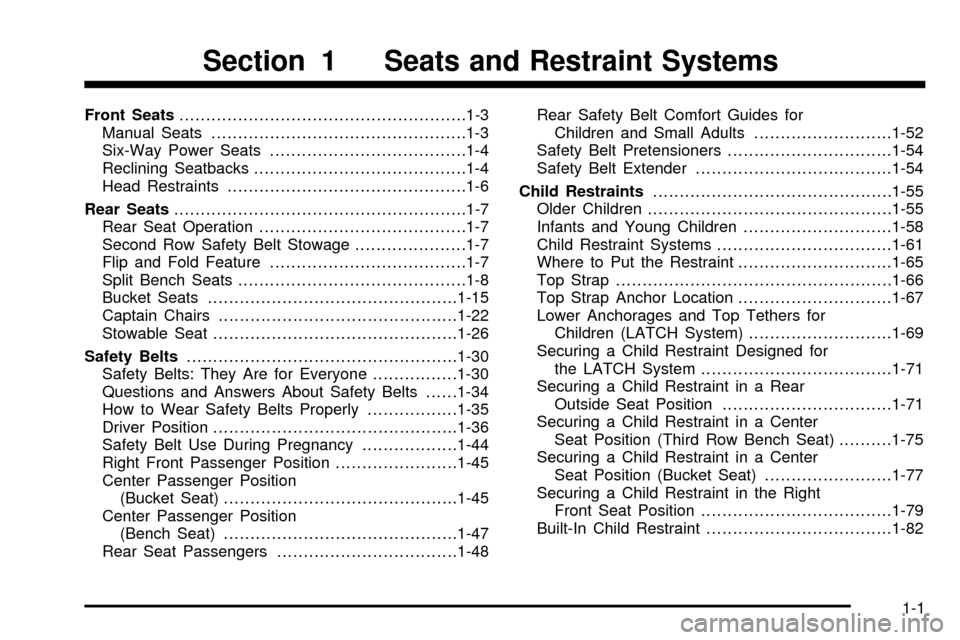
Front Seats......................................................1-3
Manual Seats................................................1-3
Six-Way Power Seats.....................................1-4
Reclining Seatbacks........................................1-4
Head Restraints.............................................1-6
Rear Seats.......................................................1-7
Rear Seat Operation.......................................1-7
Second Row Safety Belt Stowage.....................1-7
Flip and Fold Feature.....................................1-7
Split Bench Seats...........................................1-8
Bucket Seats...............................................1-15
Captain Chairs.............................................1-22
Stowable Seat..............................................1-26
Safety Belts...................................................1-30
Safety Belts: They Are for Everyone................1-30
Questions and Answers About Safety Belts......1-34
How to Wear Safety Belts Properly.................1-35
Driver Position..............................................1-36
Safety Belt Use During Pregnancy..................1-44
Right Front Passenger Position.......................1-45
Center Passenger Position
(Bucket Seat)............................................1-45
Center Passenger Position
(Bench Seat)............................................1-47
Rear Seat Passengers..................................1-48Rear Safety Belt Comfort Guides for
Children and Small Adults..........................1-52
Safety Belt Pretensioners...............................1-54
Safety Belt Extender.....................................1-54
Child Restraints.............................................1-55
Older Children..............................................1-55
Infants and Young Children............................1-58
Child Restraint Systems.................................1-61
Where to Put the Restraint.............................1-65
Top Strap....................................................1-66
Top Strap Anchor Location.............................1-67
Lower Anchorages and Top Tethers for
Children (LATCH System)...........................1-69
Securing a Child Restraint Designed for
the LATCH System....................................1-71
Securing a Child Restraint in a Rear
Outside Seat Position................................1-71
Securing a Child Restraint in a Center
Seat Position (Third Row Bench Seat)..........1-75
Securing a Child Restraint in a Center
Seat Position (Bucket Seat)........................1-77
Securing a Child Restraint in the Right
Front Seat Position....................................1-79
Built-In Child Restraint...................................1-82
Section 1 Seats and Restraint Systems
1-1
Page 11 of 486
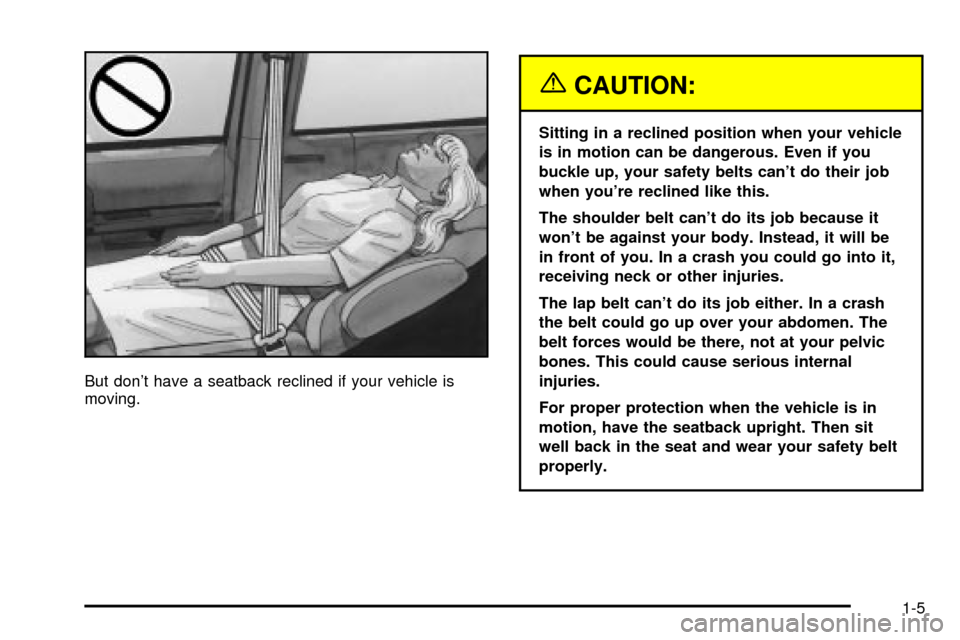
But don't have a seatback reclined if your vehicle is
moving.
{CAUTION:
Sitting in a reclined position when your vehicle
is in motion can be dangerous. Even if you
buckle up, your safety belts can't do their job
when you're reclined like this.
The shoulder belt can't do its job because it
won't be against your body. Instead, it will be
in front of you. In a crash you could go into it,
receiving neck or other injuries.
The lap belt can't do its job either. In a crash
the belt could go up over your abdomen. The
belt forces would be there, not at your pelvic
bones. This could cause serious internal
injuries.
For proper protection when the vehicle is in
motion, have the seatback upright. Then sit
well back in the seat and wear your safety belt
properly.
1-5
Page 13 of 486
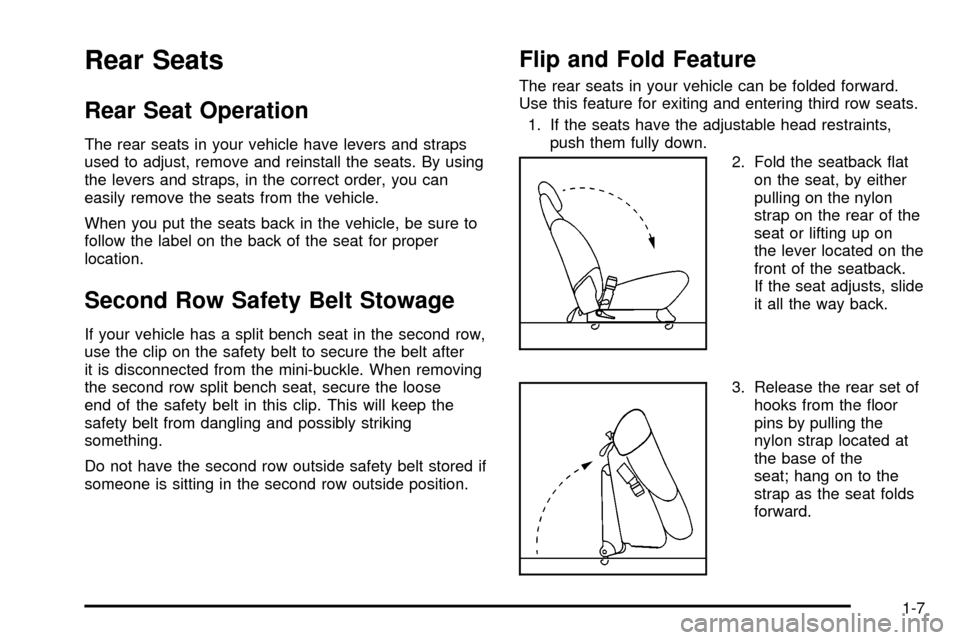
Rear Seats
Rear Seat Operation
The rear seats in your vehicle have levers and straps
used to adjust, remove and reinstall the seats. By using
the levers and straps, in the correct order, you can
easily remove the seats from the vehicle.
When you put the seats back in the vehicle, be sure to
follow the label on the back of the seat for proper
location.
Second Row Safety Belt Stowage
If your vehicle has a split bench seat in the second row,
use the clip on the safety belt to secure the belt after
it is disconnected from the mini-buckle. When removing
the second row split bench seat, secure the loose
end of the safety belt in this clip. This will keep the
safety belt from dangling and possibly striking
something.
Do not have the second row outside safety belt stored if
someone is sitting in the second row outside position.
Flip and Fold Feature
The rear seats in your vehicle can be folded forward.
Use this feature for exiting and entering third row seats.
1. If the seats have the adjustable head restraints,
push them fully down.
2. Fold the seatback ¯at
on the seat, by either
pulling on the nylon
strap on the rear of the
seat or lifting up on
the lever located on the
front of the seatback.
If the seat adjusts, slide
it all the way back.
3. Release the rear set of
hooks from the ¯oor
pins by pulling the
nylon strap located at
the base of the
seat; hang on to the
strap as the seat folds
forward.
1-7
Page 17 of 486
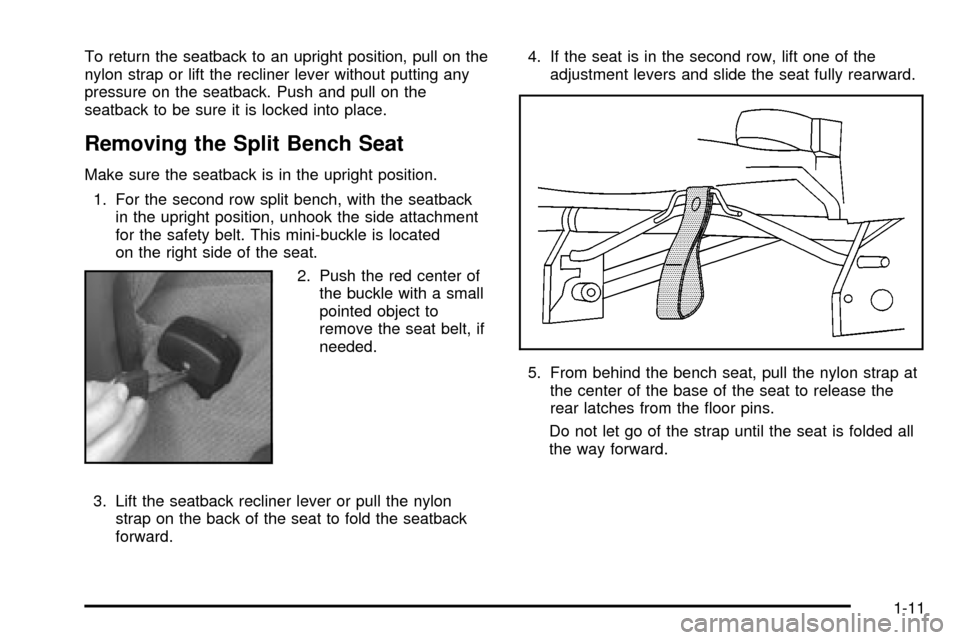
To return the seatback to an upright position, pull on the
nylon strap or lift the recliner lever without putting any
pressure on the seatback. Push and pull on the
seatback to be sure it is locked into place.
Removing the Split Bench Seat
Make sure the seatback is in the upright position.
1. For the second row split bench, with the seatback
in the upright position, unhook the side attachment
for the safety belt. This mini-buckle is located
on the right side of the seat.
2. Push the red center of
the buckle with a small
pointed object to
remove the seat belt, if
needed.
3. Lift the seatback recliner lever or pull the nylon
strap on the back of the seat to fold the seatback
forward.4. If the seat is in the second row, lift one of the
adjustment levers and slide the seat fully rearward.
5. From behind the bench seat, pull the nylon strap at
the center of the base of the seat to release the
rear latches from the ¯oor pins.
Do not let go of the strap until the seat is folded all
the way forward.
1-11
Page 19 of 486
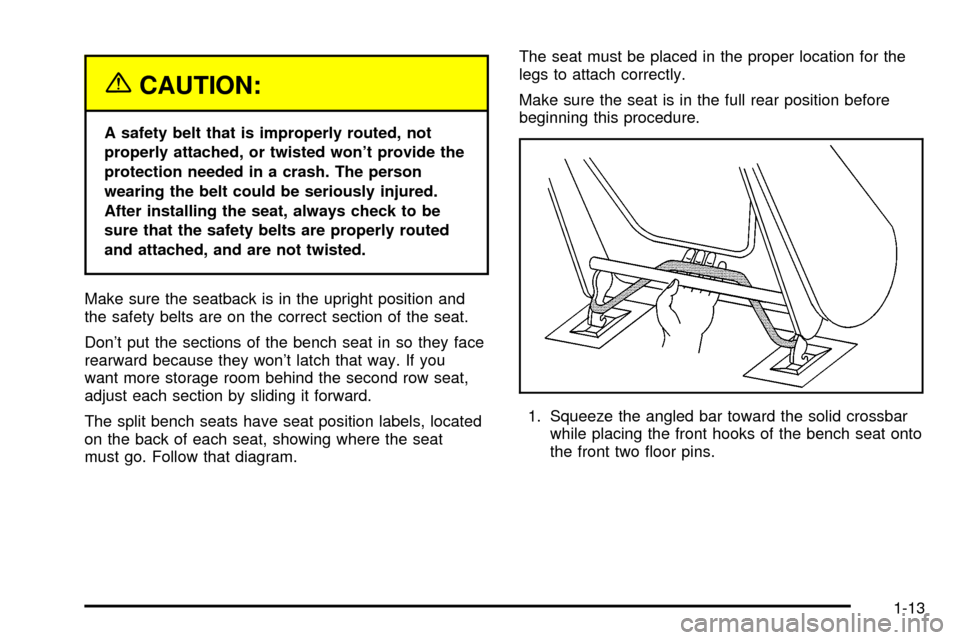
{CAUTION:
A safety belt that is improperly routed, not
properly attached, or twisted won't provide the
protection needed in a crash. The person
wearing the belt could be seriously injured.
After installing the seat, always check to be
sure that the safety belts are properly routed
and attached, and are not twisted.
Make sure the seatback is in the upright position and
the safety belts are on the correct section of the seat.
Don't put the sections of the bench seat in so they face
rearward because they won't latch that way. If you
want more storage room behind the second row seat,
adjust each section by sliding it forward.
The split bench seats have seat position labels, located
on the back of each seat, showing where the seat
must go. Follow that diagram.The seat must be placed in the proper location for the
legs to attach correctly.
Make sure the seat is in the full rear position before
beginning this procedure.
1. Squeeze the angled bar toward the solid crossbar
while placing the front hooks of the bench seat onto
the front two ¯oor pins.
1-13
Page 21 of 486

5. Lift the seatback recliner lever or pull the nylon
strap on the back of the seat and raise the
seatback until it locks upright.
6. Push and pull on the seatback to check that it is
locked.
7. If you have the 40/60 seat, attach the mini-buckle
so that the safety belt is ready for use when a
passenger uses the seat.
The buckle reattaches by pushing the latch into the
buckle until the red center pops out again.
Repeat these steps for the other section of the split
bench seat.Bucket Seats
If your vehicle has the bucket seats, the seatbacks can
be folded down or reclined. The seats can also be
adjusted forward or rearward and removed.
One of the bucket seats may be equipped with a built-in
child restraint. See
Built-In Child Restraint on page 1-82.
1-15
Page 26 of 486
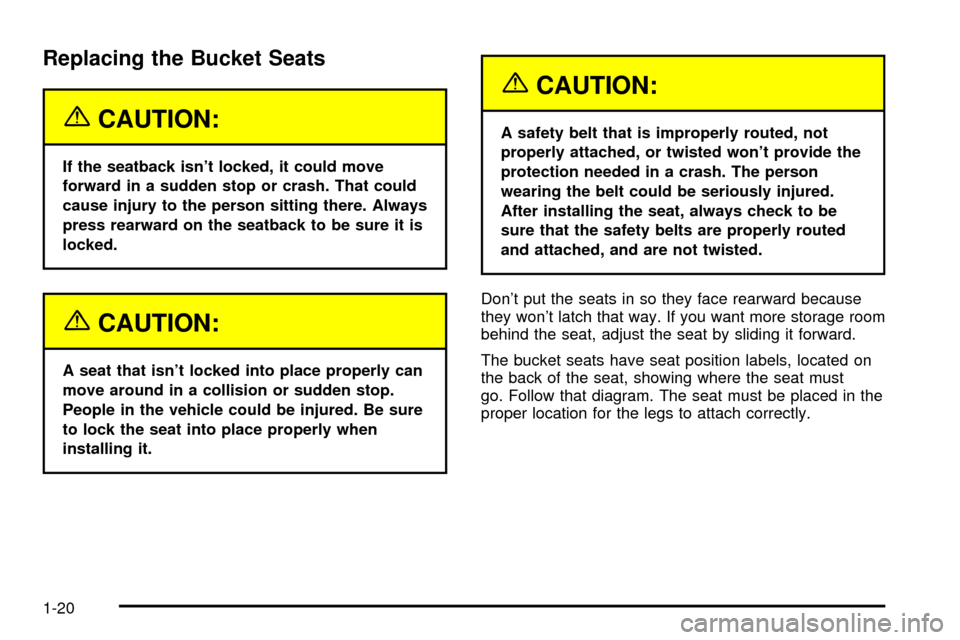
Replacing the Bucket Seats
{CAUTION:
If the seatback isn't locked, it could move
forward in a sudden stop or crash. That could
cause injury to the person sitting there. Always
press rearward on the seatback to be sure it is
locked.
{CAUTION:
A seat that isn't locked into place properly can
move around in a collision or sudden stop.
People in the vehicle could be injured. Be sure
to lock the seat into place properly when
installing it.
{CAUTION:
A safety belt that is improperly routed, not
properly attached, or twisted won't provide the
protection needed in a crash. The person
wearing the belt could be seriously injured.
After installing the seat, always check to be
sure that the safety belts are properly routed
and attached, and are not twisted.
Don't put the seats in so they face rearward because
they won't latch that way. If you want more storage room
behind the seat, adjust the seat by sliding it forward.
The bucket seats have seat position labels, located on
the back of the seat, showing where the seat must
go. Follow that diagram. The seat must be placed in the
proper location for the legs to attach correctly.
1-20
Page 31 of 486
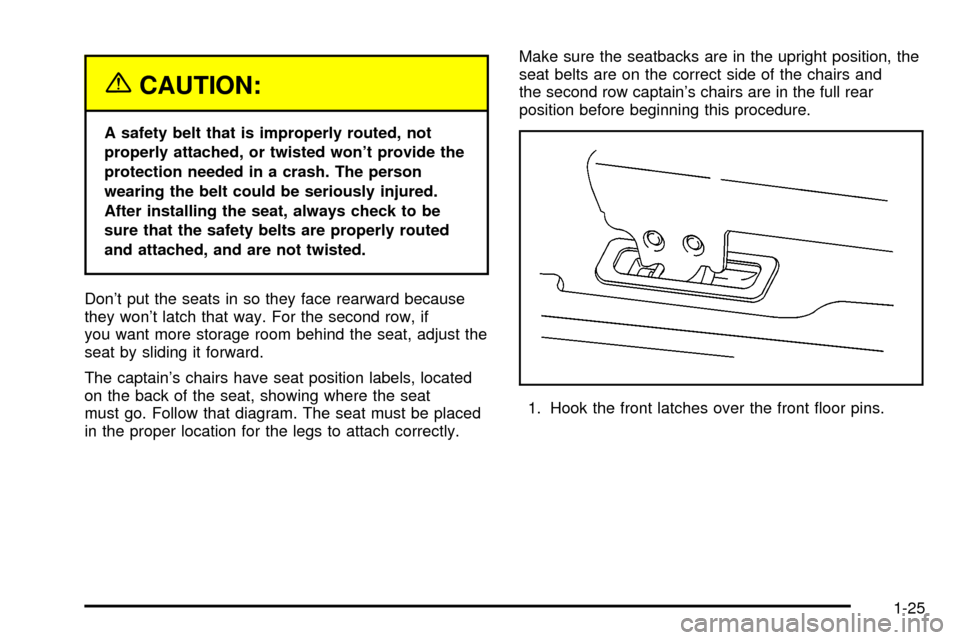
{CAUTION:
A safety belt that is improperly routed, not
properly attached, or twisted won't provide the
protection needed in a crash. The person
wearing the belt could be seriously injured.
After installing the seat, always check to be
sure that the safety belts are properly routed
and attached, and are not twisted.
Don't put the seats in so they face rearward because
they won't latch that way. For the second row, if
you want more storage room behind the seat, adjust the
seat by sliding it forward.
The captain's chairs have seat position labels, located
on the back of the seat, showing where the seat
must go. Follow that diagram. The seat must be placed
in the proper location for the legs to attach correctly.Make sure the seatbacks are in the upright position, the
seat belts are on the correct side of the chairs and
the second row captain's chairs are in the full rear
position before beginning this procedure.
1. Hook the front latches over the front ¯oor pins.
1-25
Page 35 of 486
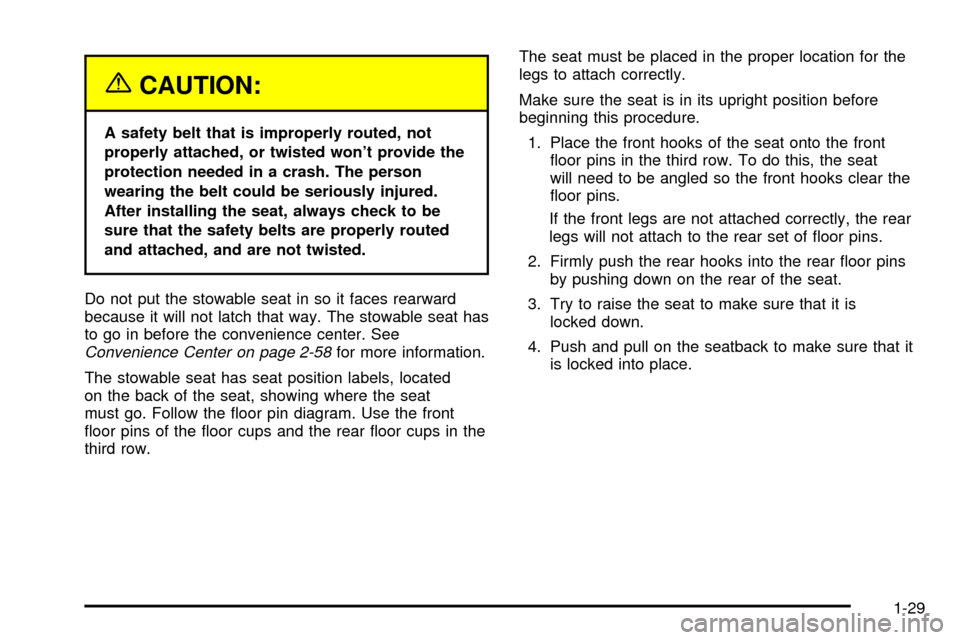
{CAUTION:
A safety belt that is improperly routed, not
properly attached, or twisted won't provide the
protection needed in a crash. The person
wearing the belt could be seriously injured.
After installing the seat, always check to be
sure that the safety belts are properly routed
and attached, and are not twisted.
Do not put the stowable seat in so it faces rearward
because it will not latch that way. The stowable seat has
to go in before the convenience center. See
Convenience Center on page 2-58for more information.
The stowable seat has seat position labels, located
on the back of the seat, showing where the seat
must go. Follow the ¯oor pin diagram. Use the front
¯oor pins of the ¯oor cups and the rear ¯oor cups in the
third row.The seat must be placed in the proper location for the
legs to attach correctly.
Make sure the seat is in its upright position before
beginning this procedure.
1. Place the front hooks of the seat onto the front
¯oor pins in the third row. To do this, the seat
will need to be angled so the front hooks clear the
¯oor pins.
If the front legs are not attached correctly, the rear
legs will not attach to the rear set of ¯oor pins.
2. Firmly push the rear hooks into the rear ¯oor pins
by pushing down on the rear of the seat.
3. Try to raise the seat to make sure that it is
locked down.
4. Push and pull on the seatback to make sure that it
is locked into place.
1-29